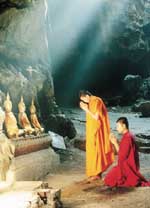|
Meditating in a Cave

Buddhist
monks reverencing Buddha lead
missioner to reflect on Christian spiritual journey.
Thailand
is among those Asian countries blessed by craggy mountains that
jut like dragons' teeth out of turquoise seas or rise unexpectedly
in emerald rice paddies. Those mountains are riddled with caves
that have become pilgrimage sites for devout Buddhists.
The caves house Buddha images, some ensconced in roomy chambers,
others sitting in solitary recesses. In former times they were
home to hermit monks, who have a unique understanding of pilgrimage.
They share the view of our own latter-day American hermit, Trappist
monk Thomas Merton, who wrote, "Our real journey in life is
interior; it is a matter of growth, deepening and an ever greater
surrender to the creative action of love and grace in our hearts."
I had reason recently to recall Merton while visiting some of
these caves, a short drive south of Bangkok. Buddhist monks
whom I teach English had expressed an interest in seeing them,
and it seemed a fitting way to finish the three-month Buddhist
rain retreat (a special time of prayer during the monsoon season).
So off we set on a cloudy day in a rented van. The first couple
of caves proved an aesthetic disappointment. But the third,
Khao Luang, in Phetchaburi, made the trip worthwhile.
This roomy chamber is illuminated by daylight from two holes
in the roof, and despite the overcast, the light was sufficient
to venerate the enormous seated Buddha. (Theravada Buddhists
do not worship in the sense that we worship God; for they see
the Buddha only as a human being who attained enlightenment.
Buddha means the fully awakened one.) Moving deeper into the
recesses, the monks sought out a row of smaller images. As they
stood there reverencing them, the sun suddenly broke through
in great shafts. God's blessed light poured out unstintingly
upon the Buddha's sons! I stood in awe of the beauty of the
moment, hoping the lens of my camera could capture it.
I couldn't help but think of Thomas Merton, who, while standing
barefoot before the Buddha images in Polonnaruwa, Sri Lanka,
experienced his own enlightenment. "I was suddenly, almost forcibly,
jerked clean out of the habitual, half-tied vision of things,"
he wrote, "and an inner cleanness, clarity, as if exploding
from the rocks themselves, became evident... All problems are
resolved simply because what matters is clear... Everything
is emptiness and compassion....I don't know when in my life
I have ever had such a sense of beauty and spiritual validity
running together in one aesthetic illumination."
Even before Vatican II declared that the Holy Spirit was at
work in all the great world religions, Merton had sensed it.
He visited Tibetan Buddhist monks, some of whom resided in caves
like these. They had moments not of communication but of communion.
Merton put it well, "My dear brothers, we are already one, but
we imagine we are not. What we have to recover is our original
unity. What we have to be is what we are."
Just as Merton's spirituality was enriched by Buddhism, a Buddhist
monk, Tich Nhat Hanh (whom Merton called friend and brother)
so grew in his love for Christ as to reverence a picture of
Jesus on his Buddha altar. This Buddhist monk wrote of the power
of the Holy Spirit in the lives of Christians.
Those shafts of light illuminating Buddhist monks as they pray
in a cave reminded me that centuries ago starlight fell upon
other wise men as they worshiped God in their own way in Bethlehem's
cave. They came from outside the Jewish tradition in which Christ
was born and undoubtedly returned to their lands to continue
to worship in their own tradition. And yet, they remain within
our Christian tradition the very symbol of how God's revelation
breaks all established boundaries.
Brother John Beeching is from Victoria, Canada.
What is Buddhism?

Five
hundred years before Christ, Siddhartha Gautama, a Nepalese
prince, reacted against Hinduism, with its countless rebirths
to higher or lower life forms depending on one's actions. Meditating
under the Bo tree, he attained enlightenment and became Buddha.
He taught that humans are responsible for creating heaven or
hell on earth.
The Four Noble Truths comprise the essence of his teaching:
All life is suffering.
All suffering comes from selfish desires.
Eliminate selfish desires and you eliminate unhappiness.
The Eightfold Path eliminates selfish desires. Many sects and
schools of Buddhism seek to perfect and refine the Eightfold
Path:
Right understanding
Right thinking
Right speech
Right conduct
Right livelihood
Right effort
Right alertness
Right meditation
The two main divisions of Buddhism are the Theravada, which
encourages the practice of personal discipline, meditation and
the attainment of wisdom to achieve Nirvana, and the Mahayana,
or Great Raft, that promotes enlightenment through meditation.
Most of Southeast Asia, especially Thailand, Laos, Cambodia,
Sri Lanka, and Myanmar, follows Theravada Buddhism. Northeast
Asia, notably Korea and Japan, practices Mahayana Buddhism.
The Theravada branch of Buddhism holds that nirvana, or the
end of suffering, ends the cycles of rebirth and may be attained
through personal effort and wisdom. On the opposite end of the
spectrum, the Zen branch of Mahayana seeks detachment from all
rituals and logic. It strives for a burst of illumination from
within.
Theologically, Buddhism is non-theistic, neither affirming nor
denying the existence of God.
Buddha denied being divine or even holy. Asked to describe himself,
he said, "I am awake."
Everyone can become a buddha according to the Mahayana. A bodhisattva
is one who delays entering nirvana in order to show others the
way. In this sense, some Buddhists consider Jesus a bodhisattva.
The hallmark of Buddhism is compassion for all living things.
The Second Vatican Council called for dialogue and collaboration
with followers of Buddhism and other non-Christian religions,
declaring: "The Catholic Church rejects nothing which is true
and holy in these religions."
JRV
Mary Knoll Magzine, Feb. 2000
|

